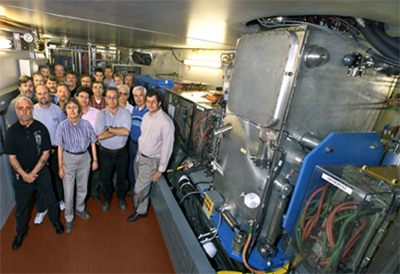Protein Structures Through use of “Superbends” at the Advance Light Source
Photo courtesy of Lawrence Berkeley National Laboratory
Advance Light Source Superbend installation.
Unique superconducting bend magnets or “superbends” were designed and installed in the Advanced Light Source at the Lawrence Berkeley National Laboratory without compromise to performance within the existing photon storage ring. The initial LDRD proof-of-principal studies justified construction and installation of several beamlines using actual “superbend” magnets. Beamline construction has been supported by DOE and other research organizations. In particular, Howard Hughes Medical Institute paid for two multi-million dollar beamlines for research on protein structures. These new capabilities were an important component, along with other work at the Stanford Synchrotron Light Source, of Roger Kornberg’s determination of the structure of RNA Polymerase II, and for which Kornberg received the 2006 Nobel Prize in Chemistry.
Why it Matters
Life science and soft condensed matter research cover a broad range of scientific interests that require measurements over a range of length scales from atoms, molecules, tissues, and organisms. Since the discovery of x-rays, methods have played an increasingly role in life sciences as evidenced by medical imaging, small-angle and wide-angle scattering, and crystallography. The availability of synchrotron sources has greatly accelerated the advances in these areas, particularly in biological crystallography.
Methods
The initial design of the Advance Light Source was based on room-temperature bend magnets that yielded a distinctly new scientific capability in the soft x-ray region. The soft x-ray energy was determined in large part by the strength of the magnetic field generated by the magnets. Stronger magnets would significantly enhance the potential science, such as for protein crystallography and small sample diffraction and adsorption studies.
The project sought to design a new superconducting, high field magnet. Three coil sets were built as proof-of-principle studies on superconducting wire, incorporating different construction methods. Following further structural analysis, a fourth coil set was designed and built with a modified structure, composition, and insulation of the wire. The results showed that this latter design reached the require quench current with no magnet training, therefore establishing the feasibility of the new approach. These results justified post-project construction and testing of a complete prototype “superbend” magnet.
What’s Next
There is growing need to extend existing x-ray structural techniques to hard-to-crystallize biomolecules and to non-periodic heterogeneous specimens. For biological systems, imaging at the cellular level has become critically important in the post-genomic era for determining the functionalities of genes and gene products identified as a result of modern molecular techniques. Advanced x-ray capabilities such as the “superbend” beamlines of the Advanced Light Source will continue to play central roles in the advances understanding biological systems.
Acknowledgments
The original “superbend” beamline R&D was led by Alan Jackson and Clyde Taylor. The project has been supported by DOE-SC and the Howard Hughes Medical Institute.
Publications
ANL, BNL, LBNL, and SLAC. 2008. “Science and Technology of Future Light Sources: A White Paper.” December.
Bushnell DA, KD Westover, RE Davis, and RD Kornberg. “Starting the ENA Assembly Line.” 2004. ALS News Vol. 244. August 25.



